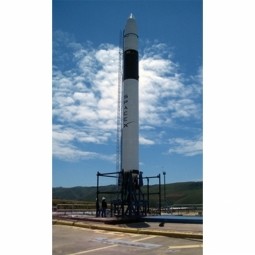Case Studies.
Our Case Study database tracks 18,927 case studies in the global enterprise technology ecosystem.
Filters allow you to explore case studies quickly and efficiently.
-
(5)
- (4)
- (1)
-
(4)
- (2)
- (1)
- (1)
-
(1)
- (1)
- (1)
-
(1)
- (1)
- (1)
-
(1)
- (1)
- View all 5 Technologies
- (2)
- (1)
- (1)
- (1)
- (1)
- View all 7 Industries
- (2)
- (2)
- (1)
- (1)
- (1)
- View all 5 Functional Areas
- (2)
- (1)
- (1)
- (1)
- (1)
- View all 7 Use Cases
- (1)
- (9)
Selected Filters
9 case studies
|
Automation of the Oguz-Gabala-Baku water pipeline, Azerbaijan
Siemens
The Oguz-Gabala-Baku water pipeline project dates back to plans from the 1970’s. Baku’s growth was historically driven by the booming oil industry and required the import of drinking water from outside of the city. Before the construction of the pipeline, some 60 percent of the city’s households received water for only a few hours daily. After completion of the project, 75 percent of the two million Baku residents are now served around the clock with potable water, based on World Health Organization (WHO) standards. The 262-kilometer pipeline requires no pumping station, but uses the altitude differences between the Caucasian mountains and the capital to supply 432,000 m³/d to the Ceyranbatan water reservoir. To the people of Baku, the pipeline is “the most important project not only in 2010, but of the last 20 years.”
|
|
Battery manufacturer Industrial Digital Twin
Siemens
For optimum control of product quality, Banner relies on a high production depth. Its 560 production employees produce nearly all the components in¬-house that they need to make finished batteries on Banner’s six assembly lines. This includes the plastic parts for the battery cases as well as the paste-filled lead oxide grids. Their production involves two to five¬ days rest in maturing chambers to create optimum current absorption and storage capacity. Banner’s ongoing success was accompanied by a continuous, organic growth of the production facilities, adding or extending hall after hall until the complex filled the site that had seemed ever so spacious when the company moved here from a smaller place in 1959. These developments led to a heterogeneous production environment. “This confronts us with significant challenges, particularly concerning intra¬logistics issues, such as scheduling for the maturing chambers,” says Franz Dorninger, technical director at Banner. “We contemplated various ways to overcome this problem, including relocating to new premises.”
|
|
Integral Plant Maintenance
Siemens
Mercedes-Benz and his partner GAZ chose Siemens to be its maintenance partner at a new engine plant in Yaroslavl, Russia. The new plant offers a capacity to manufacture diesel engines for the Russian market, for locally produced Sprinter Classic. In addition to engines for the local market, the Yaroslavl plant will also produce spare parts. Mercedes-Benz Russia and his partner needed a service partner in order to ensure the operation of these lines in a maintenance partnership arrangement. The challenges included coordinating the entire maintenance management operation, in particular inspections, corrective and predictive maintenance activities, and the optimizing spare parts management. Siemens developed a customized maintenance solution that includes all electronic and mechanical maintenance activities (Integral Plant Maintenance).
|
|
Driven by Data
Siemens
Digitalization starts with the design of a product. Maserati needs to virtually create, simulate, and test their cars in a time efficient manner. The Maserati engineers needed to manage their project collaboratively across various locations.
|
|
Siemens | Using Machine Learning to Get Machines to Mimic Intuition
Siemens
The ability to learn is a precondition for autonomy. With this in mind, Siemens researchers are developing knowledge networks based on deep learning-related simulated neurons and connections. Such networks can be used to generalize information by identifying associations between extraordinarily complex realms, such as the publicly accessible Internet and a company’s internal information systems. Far-reaching and generic, this technology appears to hold the potential of mimicking what humans call intuition.
|
|
SpaceX delivers outer space at bargain rates
Siemens
Space X wanted to develop a rocket that can reduce the cost of space access by a factor of 10.
|
|
Artificial Intelligence and the implications on Medical Imaging
Siemens
There are several factors simultaneously driving integration of AI in radiology. Firstly, in many countries around the world there is a discrepancy between the number of doctors trained in radiology and the rising demand for diagnostic imaging. This leads to greater demands for work efficiency and productivity. For example, the number of radiology specialists (consultant work- force) in England went up 5% between 2012 and 2015, while in the same period the number of CT and MR scans increased by 29 and 26 percentage points respectively. In Scotland, the gap widened even further (The Royal College of Radiologists 2016). Today, the average radiologist is interpreting an image every three to four seconds, eight hours a day (Choi et al. 2016).Secondly, the image resolution of today’s scanners is continuously improving – resulting in an ever greater volume of data. Indeed, the estimated overall medical data volume doubles every three years, making it harder and harder for radiologists to make good use of the available information without extra help from computerized digital processing. It is desirable, both in radiological research and in clinical diagnostics, to be able to quantitatively analyze this largely unexploited wealth of data and, for example, utilize new measurable imaging biomarkers to assess disease progression and prognosis (O’Connor et al. 2017). Experts see considerable future potential in the transformation of radiology from a discipline of qualitative interpretation to one of quantita- tive analysis, which derives clinically relevant information from extensive data sets (“radiomics”). “Images are more than pictures, they are data,” American radiologist Robert Gillies and his colleagues write (Gillies et al. 2016). Of course, this direction for radiology will require powerful, automated procedures, some of which at least will come under the field of artificial intelligence.
|
|
Optima As a Pilot Customer for Innovative Transport System
Siemens
Optima wanted to create a seamless digital process chain, starting with product and machine design and continuing through the engineering right on to production automation and increase the production flexibility.
|
|
Digital Twin in Pharmaceutical Manufacturing
Siemens
GSK wanted to improve their vaccine manufacturing processes and see how they could effectively optimize the development process.
|












